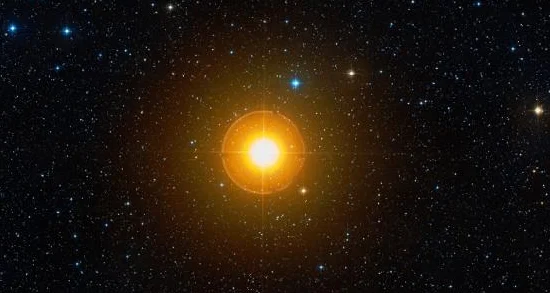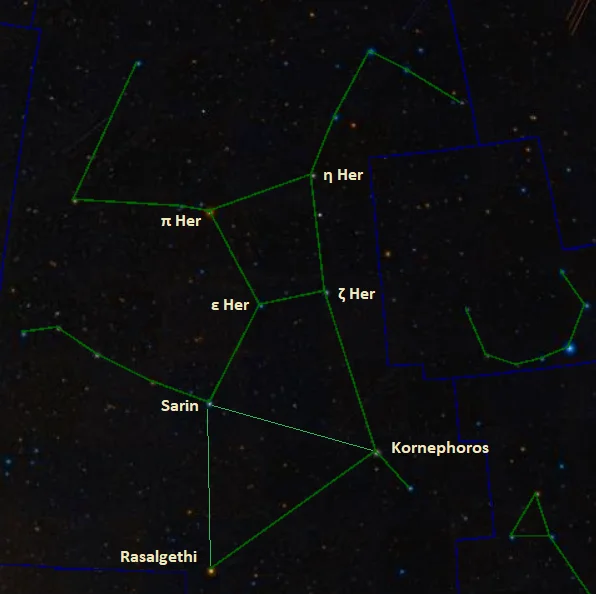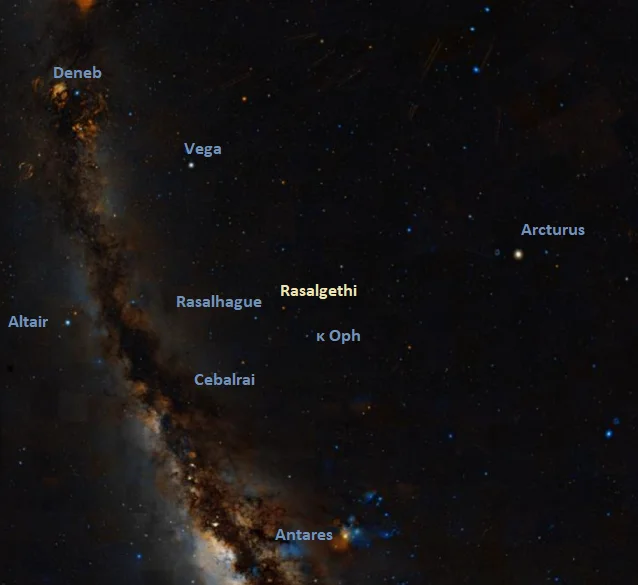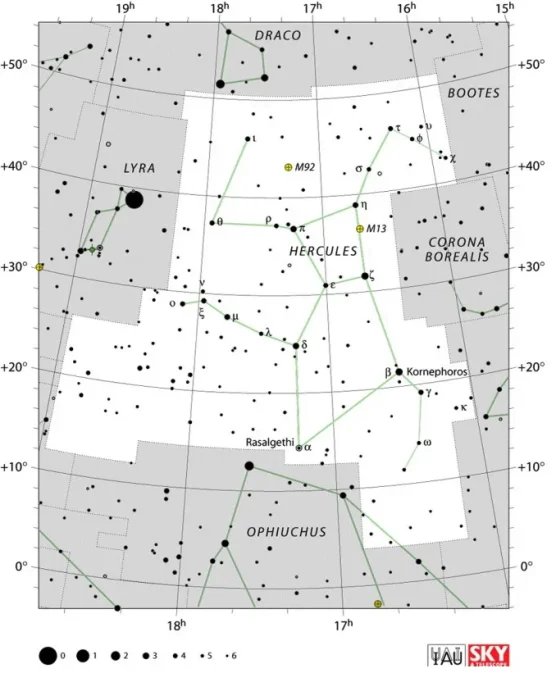Rasalgethi, Alpha Herculis A (α Her A) is a red supergiant or bright giant located in the northern constellation Hercules, near the border with Ophiuchus. The star marks the head of Hercules. With an apparent magnitude of 3.350, it is the fifth brightest star in the constellation. It is part of a multiple star system located approximately 360 light years away.
Star system
The Alpha Herculis system consists of three components. The primary component, formally named Rasalgethi and designated Alpha Herculis A or Alpha1 Herculis, is a red supergiant or bright giant of the spectral type M5 Ib-II. It has a mass between 2.175 and 3.250 solar masses and a radius between 264 and 303 times that of the Sun. With a surface temperature of 3,155 – 3,365 K, the star shines with between 7,244 and 9,333 solar luminosities.
The star’s angular diameter was measured interferometrically as 34 ± 0.8 milliseconds of arc (0.034 arcseconds) in the early 1990s. At the estimated distance of 360 light years, this corresponds to a slightly larger radius of 400 solar radii or 1.87 astronomical units. With this size, if Rasalgethi replaced the Sun in our solar system, it would extend beyond the orbit of Mars.

Rasalgethi (Alpha Herculis), image: Wikisky
Rasalgethi is a pulsating variable star classified as a semiregular variable of the type SRc. It shows irregular variations in brightness by about 0.6 magnitudes over periods of months to years, with main periods between 80 and 140 days, and 1,000 and 3,000 days. The star’s brightness has been reported to be in the range from magnitude 2.7 to 4.0, but the variations are usually over a range of 0.6 magnitudes. A photometric study of pulsating red giants published in 2001 found a main period of 128 days.
Semiregular variables of the SRc type include many other supergiants of late spectral classes. The best-known ones are the red supergiants Betelgeuse in the constellation Orion, Mu Cephei in Cepheus, T Ceti in Cetus, and VX Sagittarii in Sagittarius.
Like Rasalgethi, some of these stars are on the asymptotic giant branch (AGB). This is a late evolutionary stage of low-to-intermediate mass stars, during which the stars appear as bright red supergiants thousands of times more luminous than the Sun. The interiors of AGB stars have inert carbon-oxygen cores. During the early AGB phase, the main fuel comes from helium fusion in a shell around the core and stars expand to giant proportions. Once the helium shell is depleted of fuel, the thermally pulsing AGB phase begins, during which the main source of energy is hydrogen fusion in a thin shell. Rasalgethi has probably either stopped fusing helium or will do so soon.
The star is experiencing enormous mass loss. The ejected material has formed a gaseous envelope that stretches for 930 or more astronomical units.
Rasalgethi is not massive enough to end its life in a supernova event. Instead, when it reaches the end of its life cycle, it will expel its outer layers and gradually fade away as a massive white dwarf surrounded by a planetary nebula formed of the ejected material.
The companion, Alpha Herculis B or Alpha2 Herculis, is itself a spectroscopic binary star. It is separated by more than 500 astronomical units from Alpha1 Herculis. The two components take about 3,600 years to complete an orbit.
Alpha Herculis B is fainter than Rasalgethi, with an apparent magnitude of 5.322. The binary system consists of a yellow giant with the stellar classification G5III and a white main sequence star of the spectral type F2V. Some sources give the spectral types G8III and A9IV-V for the two components. The two stars are locked in a 51.587-day orbit.
Alpha Herculis Ba, the yellow giant, has a mass about 2.5 times that of the Sun. With an effective temperature of 4,900 K, it is 126 times more luminous than the Sun. Alpha Herculis Bb has a mass of 2 solar masses and shines with 26 solar luminosities with a surface temperature of 7,350 K.
The Alpha Herculis star system has a combined apparent magnitude of 3.08. The estimated age of the stars is between 0.41 and 1.25 billion years.
Facts
At a distance of 360 light years, Rasalgethi is the second nearest AGB star to the Sun. The nearest AGB star is Mira in the constellation Cetus, located approximately 300 light years away.
The Washington Visual Double Star Catalog lists the two main components of Alpha Herculis as the A and B components of a multiple system listed as WDS J17146+1423. The system also includes two fainter companions, catalogued as components C and D. The fainter components have apparent magnitudes of 15.50 and 11.10. They lie much farther away than the Alpha Herculis system and are just visual companions.
Name
The name Rasalgethi (pronunciation: /ˈräs-ˌal-jə-ˈtē/ or /ˈräs -al-ˈge-thē/) comes from the Arabic ra‘is al-jāthī, meaning “the head of the kneeling one.” It has also been spelled Ras Algethi, Ras Algathi, Ras Algati, Ras Alhathi and Ras Alheti.
The name refers to the star’s position in the constellation Hercules, marking the Greek hero’s head. Hercules constellation was traditionally depicted upside down, with Rasalgethi, the southernmost of the constellation’s bright stars, marking the head, Kornephoros (Beta Herculis) and Sarin (Delta Herculis) forming the shoulders, and the Keystone asterism outlining the torso.

Hercules stars, image: Wikisky
The name Rasalgethi was approved by the International Astronomical Union’s (IAU) Working Group on Star Names (WGSN) on June 30, 2016. It formally applies only to the component Alpha1 Herculis.
The name Ras al Djathi appeared in the Egyptian astronomer Al Achsasi al Mouakket’s Calendarium, written around 1650. It was later translated into Latin as Caput Ingeniculi (“the head of the kneeler”).
In Chinese astronomy, Rasalgethi is known as 帝座 (Dì Zuò), meaning Emperor’s Seat. It is the only star forming the Emperor’s Seat asterism. The asterism is part of the Heavenly Market Enclosure, which represents the emperor’s realm.
Location
Rasalgethi is relatively easy to find on a clear night. It lies just south of the imaginary line connecting the bright Altair in the constellation Aquila and Arcturus in Boötes. The star forms a distinct quadrilateral pattern with Ophiuchus stars Rasalhague, Cebalrai and Kappa Ophiuchi which can be spotted about halfway from Vega in the constellation Lyra to Antares in Scorpius. The neighbouring Rasalhague marks the head of Ophiuchus, the Serpent Bearer.

Rasalgethi location, image: Wikisky
Constellation
Rasalgethi is located in the Greek constellation Hercules. First catalogued by Ptolemy of Alexandria in his Almagest in the 2nd century CE, Hercules is one of the largest constellations in the sky. Stretching across an area of 1,225 square degrees, it is the fifth largest of all 88 constellations and the second largest constellation in the northern celestial hemisphere, after Ursa Major.

Hercules constellation map by IAU and Sky&Telescope magazine
Hercules represents the Roman equivalent of the Greek hero Heracles. The celestial Heracles is typically depicted standing on the head of the dragon represented by the neighbouring constellation Draco.
Hercules constellation is not particularly prominent in the sky, with no first or second magnitude stars. Only its two brightest stars – Kornephoros (Beta Herculis) and Zeta Herculis – shine brighter than magnitude 3.00.
Hercules is easily recognizable on a clear night because four of its relatively bright stars – Pi, Epsilon, Eta and Zeta Herculis – form an asterism known as the Keystone, which represents the torso of Hercules. The asterism can be used to find the constellation’s two best-known deep sky objects: the bright globular clusters Messier 13 (the Hercules Globular Cluster, mag. 5.8) and Messier 92 (mag. 6.3).
Other notable deep sky objects in the constellation include the globular cluster NGC 6229 (mag. 9.4), the Hercules Cluster of galaxies (Abell 2151), and the planetary nebulae Abell 39 (mag. 13.7) and the Turtle Nebula (NGC 6210, mag. 12.66).
The best time of year to observe the stars and deep sky objects in Hercules is during the month of July, when the constellation is prominent in the evening sky. The entire constellation is visible from locations between the latitudes 90° N and 50° S.
The 10 brightest stars in Hercules are Kornephoros (Beta Her, mag. 2.78), Zeta Herculis (mag. 2.81), Sarin (Delta Her, mag. 3.126), Pi Herculis (mag. 3.15), Rasalgethi (Alpha Her, mag. 3.350), Mu Herculis (mag. 3.417), Eta Herculis (mag. 3.487), Xi Herculis (mag. 3.70), Gamma Herculis (mag. 3.75), and Iota Herculis (mag. 3.80).
Alpha Herculis
| Apparent magnitude | 3.08 |
| Absolute magnitude | -2.3, 1.8, 2.8 |
| Distance | 360 light years (110 parsecs) |
| Parallax | 9.07 ± 1.32 mas |
| Radial velocity | -32.09 ± 0.22 km/s |
| Proper motion | RA: -7.32 ± 0.92 mas/yr |
| Dec.: 36.07 ± 0.97 mas/yr | |
| Age | 0.41 – 1.25 billion years |
| Constellation | Hercules |
| Right ascension | 17h 14m 38.85818s |
| Declination | +14° 23’ 25.2262’’ |
| Names and designations | Alpha Herculis, α Her, 64 Herculis, HIP 84345, BD+14°3207, AAVSO 1710+14, UBV 14596, 2MASS J17143885+1423253, CCDM J17146+1424AB, WDS J17146+1423AB, ADS 10418 AB, IDS 17101+1430 AB |
Alpha Herculis A
| Spectral class | M5 Ib-II |
| Variable type | SRc |
| U-B colour index | +1.01 |
| B-V colour index | +1.45 |
| Apparent magnitude | 3.350 (2.7 – 4.0) |
| Radial velocity | -33.1 ± 0.9 km/s |
| Proper motion | RA: -17.0 ± 2.1 mas/yr |
| Dec.: 47.0 ± 1.9 mas/yr | |
| Mass | 2.175 – 3.250 M☉ |
| Luminosity | 7,244 – 9,333 L☉ |
| Radius | 284 ± 60 R☉, 264–303 R☉ |
| Temperature | 3,155 – 3,365 K |
| Surface gravity | −0.41 ± 0.19 cgs |
| Right ascension | 17h 14m 38.852741s |
| Declination | +14° 23′ 25.33577″ |
| Names and designations | Rasalgethi, Alpha Herculis A, α Her A, Alpha1 Herculis, 64 Herculis A, HD 156014, HR 6406, SAO 102680, GC 23277, GCRV 9944, PLX 3912, IRAS 17123+1426, TYC 990-2133-1, ADS 10418 A, CCDM J17146+1424A, IDS 17101+1430 A, PMSC 17101+1430Aab, WDS J17146+1423A, WDS J17146+1423Aa,Ab |
Alpha Herculis B
| Spectral class | G5III + F2V or G8III + A9IV-V |
| Apparent magnitude | 5.322 |
| Parallax | 9.9114 ± 0.4882 mas |
| Radial velocity | -36.7 ± 0.9 km/s |
| Proper motion | RA: -8.332 ± 0.630 mas/yr |
| Dec.: 41.390 ± 0.630 mas/yr | |
| Mass (α Her Ba, α Her Bb) | ~2.5 M☉, ~2 M☉ |
| Luminosity (α Her Ba, α Her Bb) | 126 L☉, 26 L☉ |
| Temperature (α Her Ba, α Her Bb) | 4,900 K, 7,350 K |
| Right ascension | 17h 14m 39.181s |
| Declination | +14° 23′ 23.98″ |
| Names and designations | Alpha Herculis B, α Her B, Alpha2 Herculis, 64 Herculis B, HD 156015, HR 6407, SAO 102681, GC 23278, GCRV 9945, GCRV 20001, TYC 990-2134-1, Gaia DR2 4541877995116193408, ADS 10418 B, CCDM J17146+1424B, IDS 17101+1430 B, PMSC 17101+1430Bab, WDS J17146+1423B |